This was published 6 years ago
Croatia island-hopping cruises: Amazing scenery and delicious food
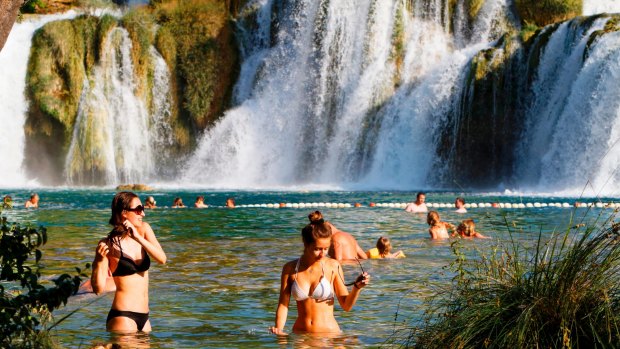
The waterfalls at Krka National Park.Credit: Alamy
The meal begins with fresh green figs stuffed with goat's milk ricotta, grilled eggplant, omelette with asparagus, cheese, a fish dish with olives, onion and rosemary, walnut pate and marsh samphire. Since we've been making appreciative noises, and the noise of food appreciation is a universal language well understood by our Croatian hosts, another dish of figs appears at our table, this time grilled on skewers, each fig wrapped in a prosciutto blanket.
The name of the restaurant is Konoba Mate in the tiny village of Pupnat, high in the hills that ridge the Croatian island of Korcula. "Konoba" denotes a rustic and traditional restaurant in Croatia, about the same as an Italian osteria, and on this warm evening we're dining al fresco on the terrace.
The feast goes on, with ravioli with goat cheese and sage sauce and macaroni with tomatoes and chilli, a big plate of grilled lamb with salad and finally chocolate with cherries, a lemon-infused cheesecake and a seriously delicious chocolate cake with orange marmalade. Apart from the chocolate, the prosciutto and the pasta it's locavore eating at the peak of late summer.
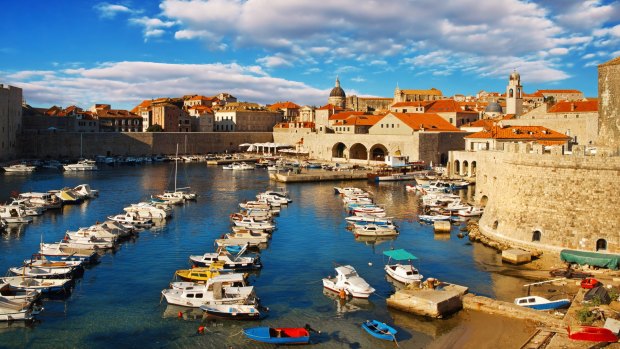
Dubrovnik Old Town Pier.Credit: Shutterstock
Konoba Mate is one of those places that transform a journey. It's neighbourly, casual and real, the kind of restaurant you might visit if you were staying with a friend with a house on Korcula. As we're leaving another diner lets it drop that Konoba Mate recently featured on Rick Stein's Venice to Istanbul foodie romp, screened on BBC TV.
I'm on an island-hopping cruise, a week exploring the Croatian coastline and its islands, taking in the sights, swimming in Windex-blue water, lapping up the sunshine, drinking fiery rakija late at night in village squares and trying to get my tongue around a language that sounds like a throat-clearing convention.
The cruise is a new venture that goes under the name Adventure Cruising, from Peregrine, the posh partner of Melbourne-based Intrepid, the world's largest small-group adventure travel operator. Last year the company chartered a modest-sized vessel for seven Croatian cruises, exclusively for Peregrine clients. Looking to capitalise on the ever-growing taste for small ship cruising, this year the Adventure Cruising portfolio will offer cruises to Cuba, Iceland, through some of the lesser-known Greek Islands, Cape Verde and along the rivers of West Africa.
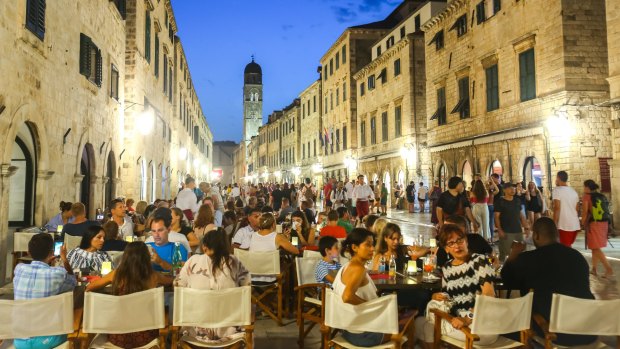
People on the terrace of the restaurant on the main city street Stradun at sunset in Dubrovnik, Croatia.Credit: Shutterstock
For decades Intrepid and Peregrine have been a well-established presence on Australia's adventure travel scene, taking mere mortals to parts of the world that often feature in wildlife docos and ferreting out one-off experiences, like Konoba Mate, that elevate the journey to somewhere north of expectations. With its new cruising arm, Peregrine is looking to apply its well-proven template of off-the-beaten-track experiences combined with a strong corporate ethos that espouses an eco-friendly, culturally immersive style of travel, and the Croatian coast is a perfect testing ground. Running for 400 kilometres from the Istrian peninsula in the north-west to the border with Montenegro in the south-east, it includes Split, Croatia's second largest metropolis, as well as World Heritage-listed Dubrovnik, but it's in the islands that the siren song is heard loudest.
The names of these islands – Korcula, Hvar, Brac and Pag – might not glide off the tongue with the same sugar-coated sibilance as "Positano" or "Saint-Tropez", yet this slice of sea-washed heaven is also subtitled "The Riviera of the Adriatic", and it fits.
The journey begins at Sibenik, about an hour's drive north of Split, set on the edge of a finger-like bay formed by the river Krka. Much of the Croatian coastline is a narrow shelf backed by limestone hills and one street back from the waterfront Sibenik rises into a labyrinth with corridors and steps instead of streets, too narrow for traffic, but ideal for the wandering tourist. The architecture is authentically medieval but there's a jarring reminder of modern history in the door of the cathedral, punctured by bullet holes during Croatia's fierce and brutal civil war, a chaser to 50 years of communism. In the afternoon we board the ship that will be our home for the next week. The Royal Eleganza is a handsome motor cruiser with room for just 31 guests. Cabins are compact but organised like a Swiss Army knife with heaps of storage space and a decent-sized bathroom. There's air conditioning throughout, and in the summer you need it, but most of the 16 cabins open to the deck to catch the sea breeze. There's a sunny top deck with day beds, Wi-Fi available in the lounge/dining room and back deck and a relaxed crew who can knock out marguerites in double-quick time.
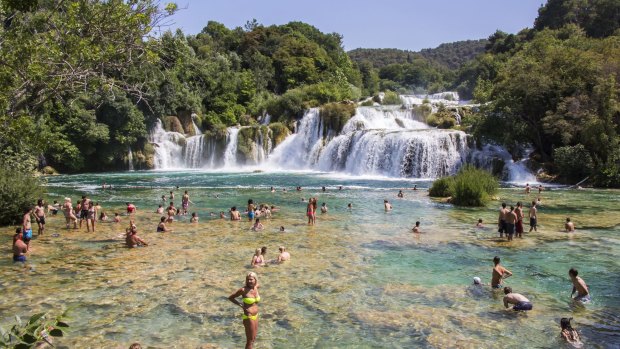
Tourists swim in the Krka National Park in Croatia. Credit: Shutterstock
Over the next few days the Royal Eleganza conjures up a string of jigsaw-shaped islands from the blue waters of the Adriatic. Early one morning we board a bus and drive across the Bosnian border to visit Mostar and its legendary bridge. At Krka National Park we swim in chilly freshwater falls that come tumbling down from a mountain spring. On Hvar we drive through a classic Mediterranean landscape of olive trees, vineyards, and lavender fields. The distinctive feature of Hvar is dry stone walls that terrace the island into a grid of tiny fields. The town of Hvar, close to the western end of the island, is one of the superstars of this part of the world, as testified by the showcase of gleaming nautical hardware along its quay and the smart waterfront cafe where an iced coffee sets me back $15.
Hvar has a reputation as a party town. At the end of the quay is a famous nightclub, Carpe Diem, which set the tone for the town when it opened several decades back. The nightclubs spread and became louder, until the residents imposed a noise curfew. No problem though, when the curfew kicks in the partygoers head off to another club on a neighbouring island where the party goes on as long as someone is left standing.
Our ship is berthed at Hvar Island's second town, Stari Grad, where we dine that night at a restaurant in a courtyard garden. There's antipasto for starters and caprese salad followed by peka, a Croatian lamb dish cooked with potatoes and other vegetables for hours on top of a stove beneath a bell-shaped cover like a tagine. As we walk back along the quay a fireworks display lights up the night sky, a fitting end to a cracking day.
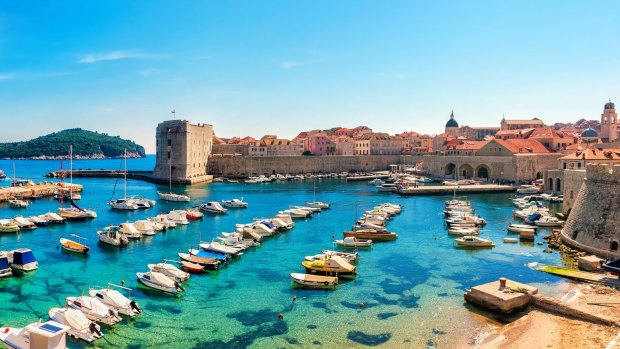
Beautiful sunny day over the bay in front of old town of DubrovnikCredit: Shutterstock
The town of Korcula on the island of the same name is my favourite, a mini fortress encased in honey-coloured walls crowned by a church. Korcula claims Marco Polo as one of its native sons and this was once an outpost of the Venetian empire, set on a major trading route, enriched by the exotic cargoes that once passed through its hands.
A large part of the charm of these island towns is down to their architecture. The villagers used the abundant supply of limestone the islands provide, from which they built houses with red tiled roofs and window shutters in villages spiked with church spires and overshadowed by hilltop forts. After the withdrawal of the Venetian Empire, relative poverty preserved these island towns from aluminium window salesmen and cement block improvements, and in an age with a taste for the past they are blessedly intact, perfect models of medieval and renaissance vernacular architecture.
After a couple of nights in the islands we spend an evening wandering around Diocletian's palace at Split, and all agree, if you're a Roman Emperor, you get to pick the primo spot for your retirement villa. Born on the Dalmatian coast, Diocletian rose through the ranks of Rome's military machine to become emperor at the end of the 3rd century AD. He abdicated in 305 and spent his last years at this vast walled compound he created on the Bay of Aspalathos. Diocletian was buried within the city, although his mausoleum was made into a Christian church, the oldest cathedral in the world according to my guide, Milan, and an ironic end for an emperor renown for his persecution of Christians. Once a formidable piece of military engineering, today Diocletian's palace is a town within the city, a maze of cobbled alleys and marbled-paved piazzas lined with jewellers, art galleries and cafes that ply their trade from facades that were carved out 1700 years ago.

Hvar, CroatiaCredit: Michael Gebicki
The cruise ends at Dubrovnik but for the previous two nights we tie up at Opuzen. It's a medium-size town on the river of the same name, and vessels rarely come this way. Rare enough that when we motor along the river and tie up at Opuzen's wharf, there's a two-man band serenading us with piano accordion and guitar, accompanied by a noisy chorus of sparrows in the chestnut trees along the river. They're happy to see us. A dozen or so townsfolk have even come out for the event. The duet play John Denver's Take Me Home Country Roads then segues into an Elvis Presley medley while we knock back thimble-size glasses of grappa and fruit-flavoured rakija. It's Friday night and after dinner I saunter into the local square. Some kids are kicking a football around, their hoots echoing off the bleached walls of the square. There's music here too, a rock band, and the singer is one hard rocking mamma, with a whisky-poured-over-gravel voice that comes from somewhere between Patti Smith and Amy Winehouse. It's not at all what you expect. I sit down for a pistachio gelato at one of the cafes that ring the square, and I'm the only tourist there.
TRIP NOTES
MORE

Old centre of Sibenik, St James cathedral in Sibenik, UNESCO world heritage site.Credit: Shutterstock
FLY
Singapore Airlines has daily one-stop flights from Adelaide, Brisbane, Cairns, Canberra, Darwin, Melbourne, Perth and Sydney to Rome and Frankfurt, with frequent onward flights to Split and Dubrovnik from both. singaporeair.com
TOUR
The 8-day Croatia Coastal Cruising trip costs from $2985 per person. See peregrineadventures.com
Michael Gebicki was a guest of Peregrine Adventures.
See also: The most overlooked paradise in the Adriatic
See also: Tips for a week of walking in Croatia
Sign up for the Traveller Deals newsletter
Get exclusive travel deals delivered straight to your inbox. Sign up now.